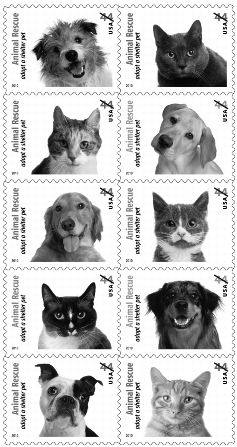The 2010 postage stamp program included several popular releases, continuing a long tradition of stamps that are unique, functional, educational, and entertaining.
Of the 25.5 billion stamps, stamped envelopes, and stamped cards produced this year, 6.3 percent were commemorative stamps. Commemorative subjects included tributes to Negro Leagues Baseball, the Boy Scouts of America, Mother Teresa, Animal Rescue: Adopt a Shelter Pet, Katharine Hepburn, Winslow Homer, Kate Smith, and 10 new stamp designs in the Flags of Our Nation series, featuring the Stars and Stripes plus the states of Montana through North Dakota (in alphabetical order). Four special panes of stamps, Distinguished Sailors, Cowboys of the Silver Screen, the Sunday Funnies, and the final pane in the Nature of America series, Hawaiian Rain Forest, were also issued. In addition, a stamp featuring the Monarch butterfly was released, the first designed specifically for use on greeting cards that require additional postage.
Most ideas for the commemorative stamp program come from the American public. Each year, 50,000 people send in proposals for consideration by the Citizens’ Stamp Advisory Committee, a cross section of designers, historians, and educators, who narrow the selection of stamp subjects to be issued. The Committee reviews the suggestions and makes recommendations to the Postmaster General for final approval. The time between submitting an idea and issuing the stamp can take several years of deliberate discussion and design. Information about the program can be found at www.usps.com/communications/organization/csac.
In addition to using stamps to commemorate people, events, and places, the Postal Service also issues stamps to help fund causes mandated by Congress. There currently is one 55-cent fundraising, or semipostal, stamp: the Breast Cancer Research stamp. Since its initial release in 1998, more than 894 million have been sold, raising more than $70.8 million for breast cancer research. The price of a semipostal stamp pays for the First-Class Mail single-piece postage in effect at the time of purchase, plus an amount to fund the cause. By law, 70 percent of the net amount raised by the Breast Cancer Research stamp is given to the National Institutes of Health and 30 percent to the Medical Research Program at the Department of Defense.

